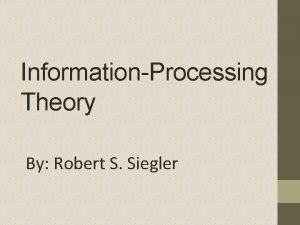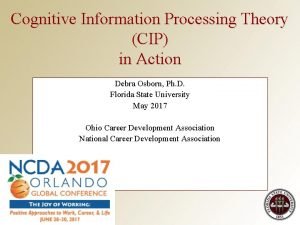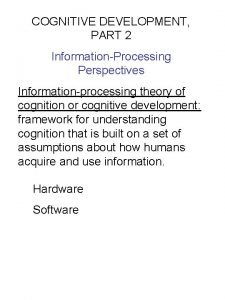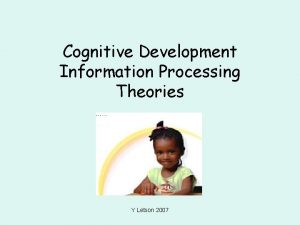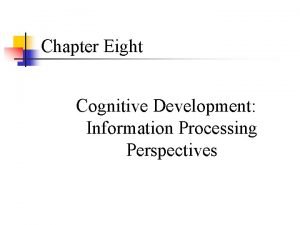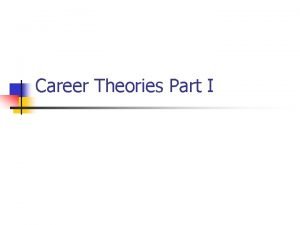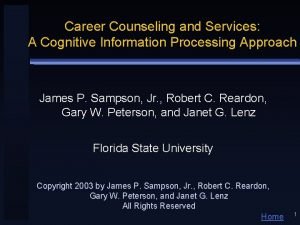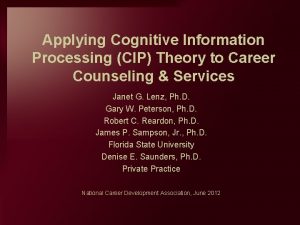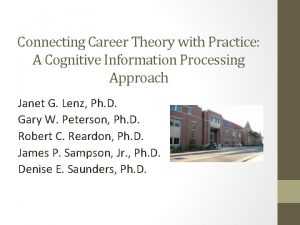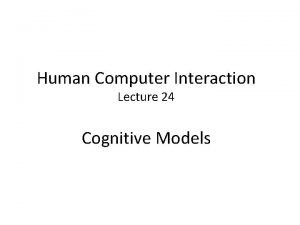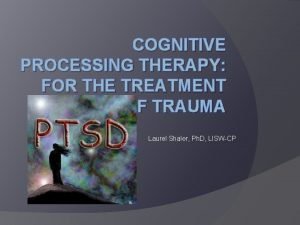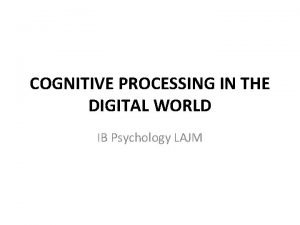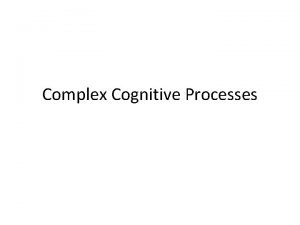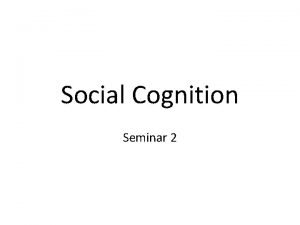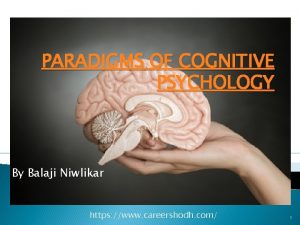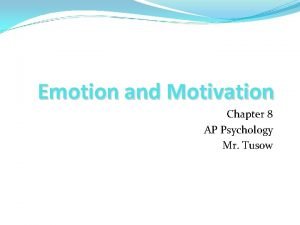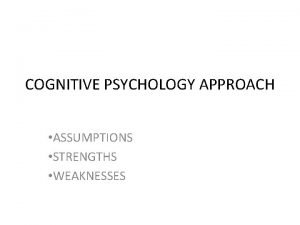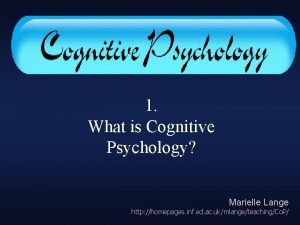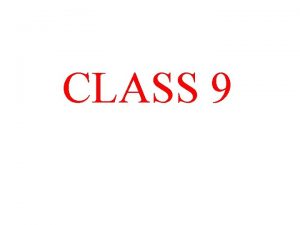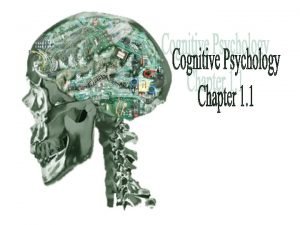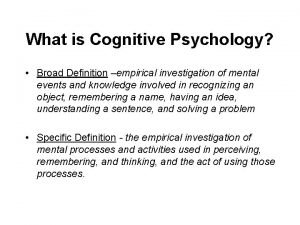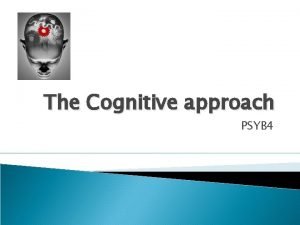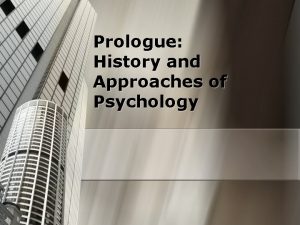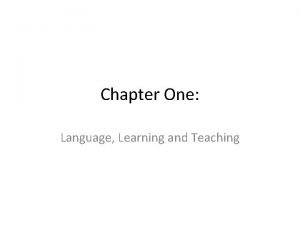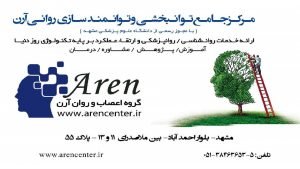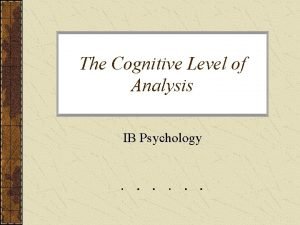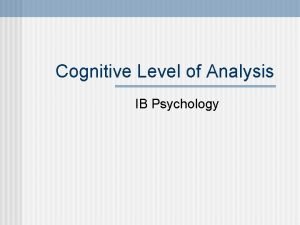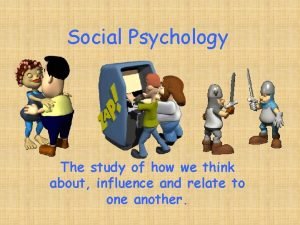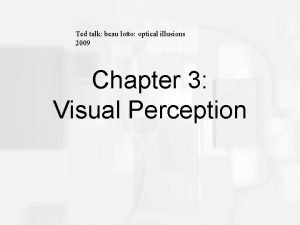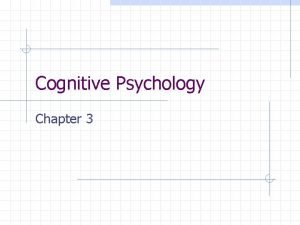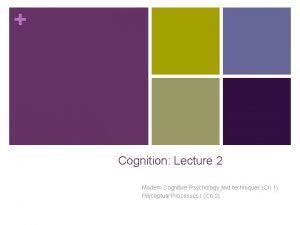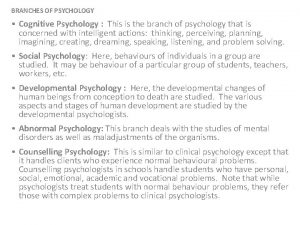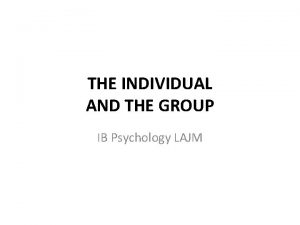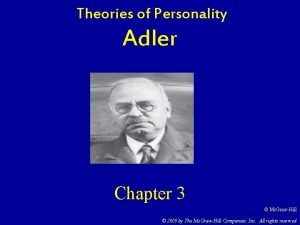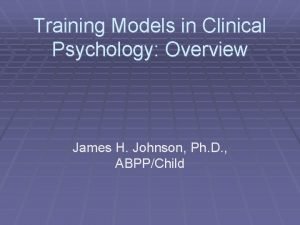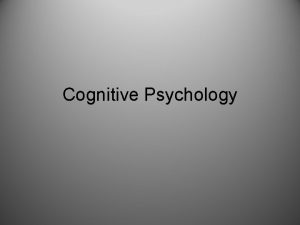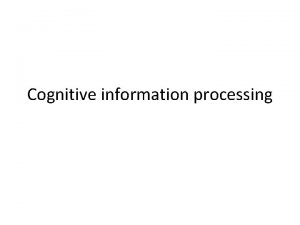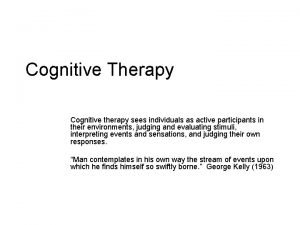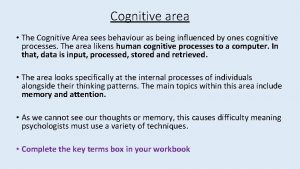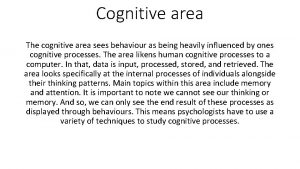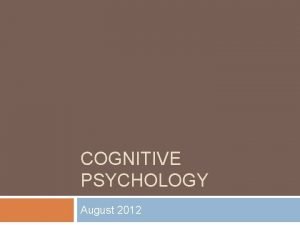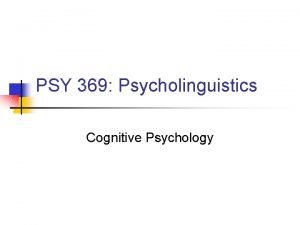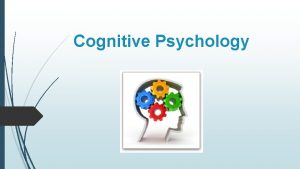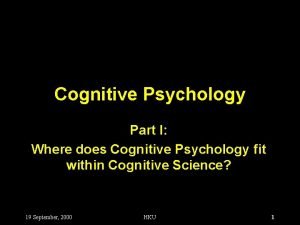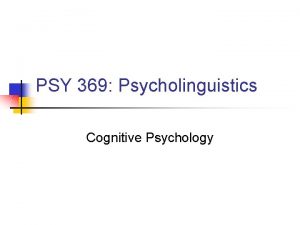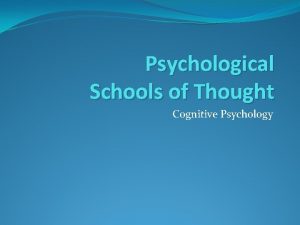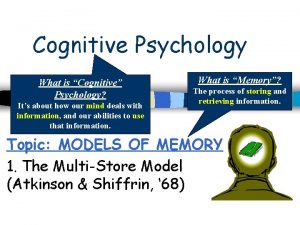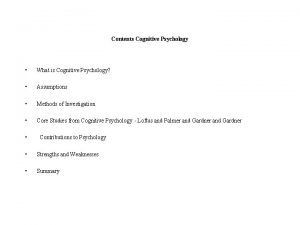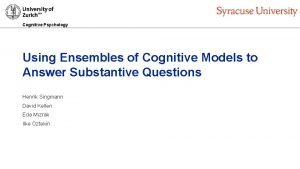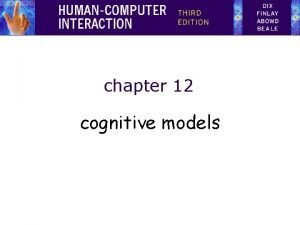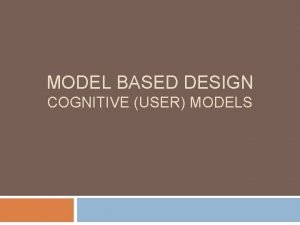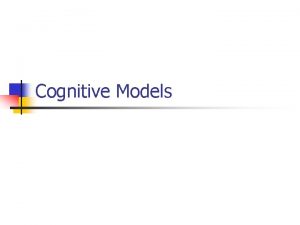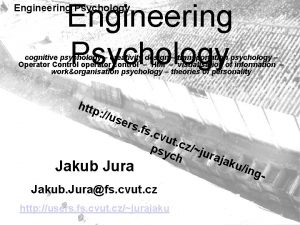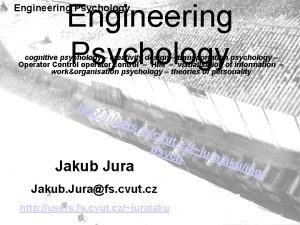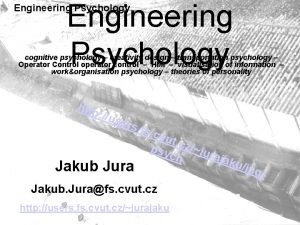Cognitive psychology Information processing models Sees the individual















































- Slides: 47

Cognitive psychology - Information processing models ■ Sees the individual as a processor of information, in much of the same way that a computer takes in information and follows a program to produce an output. ■ A computer codes (i. e. changes) information, stores information, uses information and produces an output (retrieves information).

APPLICATION TO BRAIN ■ * Input processes are concerned with the analysis of the stimuli. ■ * Storage processes over everything that happens to stimuli internally in the brain and can include coding and manipulation of the stimuli. ■ * Output processes are responsible for preparing an appropriate response to a stimulus.

MEMORY

Defining Memory. ■ Memory is an active information processing system that receives, stores, organises and recovers information

Memory processes

MULTI-STORE MODEL OF MEMORY Atkinson and Shiffrin, 1968

multi store model of memory – Atkinson and Shiffrin, 1968 ■ Suggests that if information is to be stored it must pass through three memory stores: – sensory memory, – short-term memory – long-term memory. ■ Each store operates independently but all operate at the same time and their control processes are interrelated

multi store model of memory – Atkinson and Shiffrin, 1968 ■ Each memory store is characterised by three differences. – Capacity – how much information can be stored? – Duration - How long can the information be stored? – Function – what is done with the stored information?

multi store model of memory – Atkinson and Shiffrin, 1968

Part 1 - Sensory memory. ■ New sensory information in the form of sight, sound, taste, smell and touch enters memory when it is registers in sensory memory. ■ Sensory memory only stores this information briefly – for up to a few seconds only, and the information is encoded rapidly, based on the physical properties of the stimulation. It is then transferred into STM store for further processing. Storage capacity is relatively unlimited. ■ Information is held in its original form. ■ If we ignore information in our sensory register it fades rapidly.

Part 1 – Sensory Memory ■ Two main sensory registers – Iconic memory – for visual information such as shape, colour, size. Information is held as an exact replica of visual information (an icon). Stored for approximately 1/3 – 1/2 of a second. – Echoic memory – for auditory information. Information is held as exact replica of auditory information (an echo). Stored for approximately 3 -4 seconds.

Part 2 – short term memory. ■ STM holds all the thoughts, information and experiences that you are aware of at any given point in time. ■ STM receives information from two sources – sensory memory and long term memory. ■ stores a limited amount of information (7 items +/- 2) for a brief period (18 -20 seconds), unless that information is rehearsed. ■ If information is not attended to it is forgotten, if it is attended to further processing and encoding occurs.

Read the following numbers, then look away and write as many of the numbers as you can remember. 8 5 1 7 4 9 1

Read the following numbers, then look away and write as many of the numbers as you can remember. 7 1 8 3 5 4 29 1 6 4 3

Influencing STM The following concepts can effect short term memory. 1. Chunking 2. Rehearsal (elaborative or maintenance) 3. Serial position effect.

Influencing STM – chunking. ■ Can increase STM capacity! ■ if we group separate items of information together so they form a larger single item, we can effectively increase STM normal capacity range of 7 (+/- 2) items. ■ Chunking is more effective when single items are arranged into chunks that are similar to information already stored in LTM

Read the following letters, then look away and write as many of the numbers as you can remember in the correct order. TV IBM NFL VIC

Influencing STM – Maintenance Rehearsal ■ repeating the information (silently or verbally) a number of times so it can be held in STM for longer than usual. Research shows – more times information is rehearsed, longer it is held in STM. Pros Cons good for storing meaningless information. Easily interrupted by new info entering STM Doesn’t add to understanding Restricts new info into STM. Limited effectiveness in transferring information from STM to LTM.

Influencing STM – Elaborative Rehearsal ■ – linking new information in some meaningful wat with information already held in LTM, or with other pieces of new information to hold it in STM for longer than usual. Pros Cons Increases understanding because it requires deep processing. Takes longer than maintenance rehearsal. Adds more detail, which increases chance of retrieval. Increases possibility of LTM retention because it organises new information according to meaning. Makes it more accessible because it creates more potential retrieval cues. Is difficult to practice in situations where information is entering STM rapidly/changing. Relies on the ability to retrieve information previously stored in LTM. Requires more conscious effort that maintenance rehearsal.

■ Influencing STM – serial position A pattern of recall for a list of items, where recall is better for effect. items at the beginning or end of a list than for items in the middle. – Recency effect – when items at the end of a list are easier to remember. – Primacy effect – if recall of a list is delayed, attention shifts from the last items, to the first items causing the recency effect to be lost and replaces.

Part 3 - Long term memory. ■ Once information in STM has been processed it is transferred into the LTM, ■ When required at a later date, we retrieve information by locating it in LTM and returning it to conscious awareness. i. e. info can flow from STM -> LTM and from LTM -> STM. ■ Information in LTM is stored in an organised manner based on meaning and importance.

LTM Procedural actions and skills Declarative Facts and rules Semantic memory (“meaning”) i. e. names of objects, simple maths skills etc. impersonal factual knowledge about the world. Semantic memory holds the information that we use to make meaning of the world around us. Doesn’t use personal events in time/place. Episodic memory (“time and place”) stores personally significant events or episodes that are related to a specific time and place. These are the least resistant to forgetting

WORKING MEMORY MODEL. Baddeley and Hitch (1974)

Reviewing Short Term Memory. Original view of STM: – STM is a single memory store, and that holding information there is sufficient for it to be transferred into LTM. in recent years STM view has been challenged. – It does not account for evidence that information is not just passively held in STM it is also actively manipulated or “worked on” – More complex than STM explanation.

Working memory model (Baddeley and Hitch, 1974) ■ STM not just one store, but a number of different stores or SUBSYSTEMS each having a specialised function. Why did they think this? ■ When doing 2 tasks at the same time that are similar e. g. both visual, performance is worse than when doing them separately ■ E. g Visualising a football game on the radio when driving caused Baddeley to veer off the road ■ When doing 2 different tasks e. g. visual and acoustic, there is no interference and both are done equally well.

Working memory model (Baddeley and Hitch, 1974) They suggested STM is an active, multi component memory system that performs a variety of tasks. – Working memory temporarily stores and manipulates a limited amount of information needed to perform cognitive tasks. – WM holds all the information needed for cognitive activities such as thinking, planning and analysis. – In this way, working memory holds the information you are consciously thinking about now.

Working memory model (Baddeley and Hitch, 1974)

1. Central Executive. ■ Monitors, coordinated and integrates information received from the three slave systems (phonological loop, visual spatial sketchpad and episodic buffer) and LTM. ■ Plays a major role in directing attention to relevant information and supressing irrelevant information. ■ It has a limited capacity, and can store information for approximately 18 -20 seconds without rehearsal.

2. Phonological Loop ■ The area of working memory that stores a limited number of sounds (speech based and acoustics) received from the echoic memory and/or LTM ■ This has two subsystems Phonological store. • inner ear (linked to speech perception) • holds the representations of sound for 1. 5 -2 seconds These then fade away unless they are taken up by the articulatory control system Articulatory Control System • inner voice (linked to speech production). • Used to rehearse and store verbal information from the phonological store.

3. Visual Spatial Sketchpad. ■ inner eye ■ The area of working memory that briefly stores a limited amount of visual and spatial information that is received from iconic memory or LTM. ■ It deals with what information looks like and how it is laid out in space by representing information in the form of visual features, such as size, shape, colour, or the location or speed of an object in space.

4. Episodic Buffer. ■ The area of working memory that briefly stores a limited amount of sound based information from the phonological loop and the visual and spatial information from the visual spatial sketchpad with information retrieved from LTM, ■ integrates all together into a single multi-dimensional representation or “episode”.

THEORIES OF FORGETTING

Key concepts Define forgetting: ■ Forgetting can be defined as a failure to retrieve what has been previously stored in LTM. ■ The four theories of forgetting: – retrieval failure, interference, motivated forgetting, decay

Retrieval Failure. ■ Suggests that many memories are inaccessible because memory cues that were present when the memory was formed are not present at the time you’re trying to retrieve them. ■ Information is not lost, we just can’t find the right cue to retrieve it. (a cue is any information that helps you retrieve the required information from LTM)

Example study Study by Mantyla (1986) gave participants 600 words to remember. ■ They were asked to read the list, and for each word were told to write down three other words that were closely related in meaning. ■ When the students were later tested the related words each participant supplied were used by the experimenter as cues to prompt memory of the original list of words. ■ Using this process, the students recalled 90% of original list!

Interference. ■ Refers to the tendency of for existing memories, either new or old, to impair the retrieval of a required memory. ■ Information is not lost from storage, but can not be successfully retrieved because related or similar information gets mixed up, or blocks retrieval. ■ 2 forms of interference: retroactive and proactive

Example study. Study 1 ■ 20 lists over 20 days = 15% recall. ■ 1 list over 20 days = 80% recall. Study 2 ■ Participants who learnt 80 nonsense words then slept, had better recall than participants learning the words then going about daily activities

Interference • retroactive interference – the tendency for new information to obstruct the retrieval of previously learnt information. i. e. learning new classes names, tend to forget last years classes • Proactive interference – the tendency for previously learnt information to obstruct the retrieval of newly learnt information. i. e. you have recently changed your ipad lock code, however your old code is the one you keep recalling when you open your ipad in class.

Motivated forgetting ■ This theory states that forgetting of LTMs occur because of a conscious or unconscious desire to block painful or traumatic memories from entering conscious awareness. ■ To protect from thoughts that may cause us distress and grief, which therefor allows us to get on with our day to day activities.

Motivated forgetting Can occur in two forms!! – Repression – where an individual unconsciously blocks painful or traumatic memories from entering conscious awareness. i. e. returning war veterans can not remember the horrors they faced during combat. – Suppression - where an individual consciously/deliberately blocks painful or traumatic memories from entering conscious awareness. i. e. if your parents are getting divorced, and you are “choosing to not think about it” or asking your friends to stop talking about it so you don’t have to think about it.

Decay theory ■ States that forgetting occurs due to the gradual fading/disintegrating of memory traces over time due to disuse. ■ Also occurs in information loss from sensory memory and STM Limitations of decay theory – Doesn’t account for our ability to be able to recall forgotten memories that have been stored and not used for a long time. – Elderly have strong memory of specific things or events that occurred long ago, but can not remember what they did last week.

Measuring what a person remembers Testing whether the memory is still in LTM This is done by – recall, – recognition, – re-learning

1 – recall. ■ Involves retrieving stored information using few or no cues for assistance. ■ To supply or reproduce facts or information that is stored in LTM. – Free recall – recalling information from memory in any order with no cues or assistance – Serial recall – recalling information from memory in the order or sequence it was learnt, with no cues or assistance – Cued recall – recalling information from memory with some cues or hints for assistance.

2 - recognition ■ Involves identifying previously learnt information from a group or list of alternatives. ■ Recognition has been found to be more effective for visual stimuli. ■ More successful than recall. Even patients suffering from amnesia can recognise words that they have learnt but not recall them.

2 – recognition ■ This can be affected by distractors i. e. in multiple choice questions. ■ 1. If a distractor is very similar to a correct item, recognition can be poor/unreliable. ■ 2. If a distractor looks like it could be correct more than the rest, can cause a ‘false positive’ - an incorrect sense of recognition.

3 – re-learning. ■ Involves learning information that has been previously learnt and stored in LTM as a means of assessing whether any information was retained from the previous learning, that can’t be accessed by cues or prompts. ■ Superior measure of memory to recognition and recall. If a participant relearns material fast, it is assumed that some of the information must be retained. Allows you to access memory stores that cannot be accessed by other methods.

3 – relearning ■ Saving score = a formula that calculates the percentage of information retained from original learning after relearning is occurred. This is calculated by (Time for original learning – time for relearning) ■ Saving score = time for original learning. X 100
 What do information processing theories focus on
What do information processing theories focus on Cip theory
Cip theory Information processing theory of cognitive development
Information processing theory of cognitive development Information processing theory of cognitive development
Information processing theory of cognitive development Cognitive information processing theory
Cognitive information processing theory Cognitive information
Cognitive information Pyramid of information processing domains
Pyramid of information processing domains Cip theory
Cip theory Cognitive information processing pyramid
Cognitive information processing pyramid Cognitive and non cognitive religious language
Cognitive and non cognitive religious language Cognitive model in hci
Cognitive model in hci Trauma impact statement worksheet
Trauma impact statement worksheet Cognitive processing in the digital world
Cognitive processing in the digital world Complex cognitive processes
Complex cognitive processes Semi modal verbs
Semi modal verbs Cognitive psychology concepts
Cognitive psychology concepts Balaji psychology
Balaji psychology History of cognitive psychology
History of cognitive psychology Ap psychology chapter 8 emotion and motivation test
Ap psychology chapter 8 emotion and motivation test Cognitive approach strengths
Cognitive approach strengths Cognitive psychology concepts
Cognitive psychology concepts Cognitive economy psychology definition
Cognitive economy psychology definition Computer metaphor in cognitive psychology
Computer metaphor in cognitive psychology History of cognitive psychology
History of cognitive psychology History of cognitive psychology
History of cognitive psychology Cognitive meaning in psychology
Cognitive meaning in psychology Essay on cognitive approach
Essay on cognitive approach Cognitive psychology crash course
Cognitive psychology crash course Cognitive model psychology
Cognitive model psychology Structural linguistic and behavioral psychology
Structural linguistic and behavioral psychology Cognitive psychology ppt
Cognitive psychology ppt Dual processing model ib psychology
Dual processing model ib psychology Cognitive levels of development
Cognitive levels of development Cognitive dissonance ap psych
Cognitive dissonance ap psych Psychotherapy ap psychology definition
Psychotherapy ap psychology definition Cognitive psychology
Cognitive psychology Transduction psychology
Transduction psychology Cognitive psychology
Cognitive psychology Cognitive psychology branches
Cognitive psychology branches Fundamentals of image compression
Fundamentals of image compression Hamilton and gifford 1976 ib psychology
Hamilton and gifford 1976 ib psychology Exaggerated physical deficiencies
Exaggerated physical deficiencies Models of clinical psychology
Models of clinical psychology Top-down processing vs bottom-up processing
Top-down processing vs bottom-up processing Bottom up processing vs top down processing
Bottom up processing vs top down processing Bottom up processing
Bottom up processing High boost filtering matlab
High boost filtering matlab Primary processing and secondary processing
Primary processing and secondary processing
